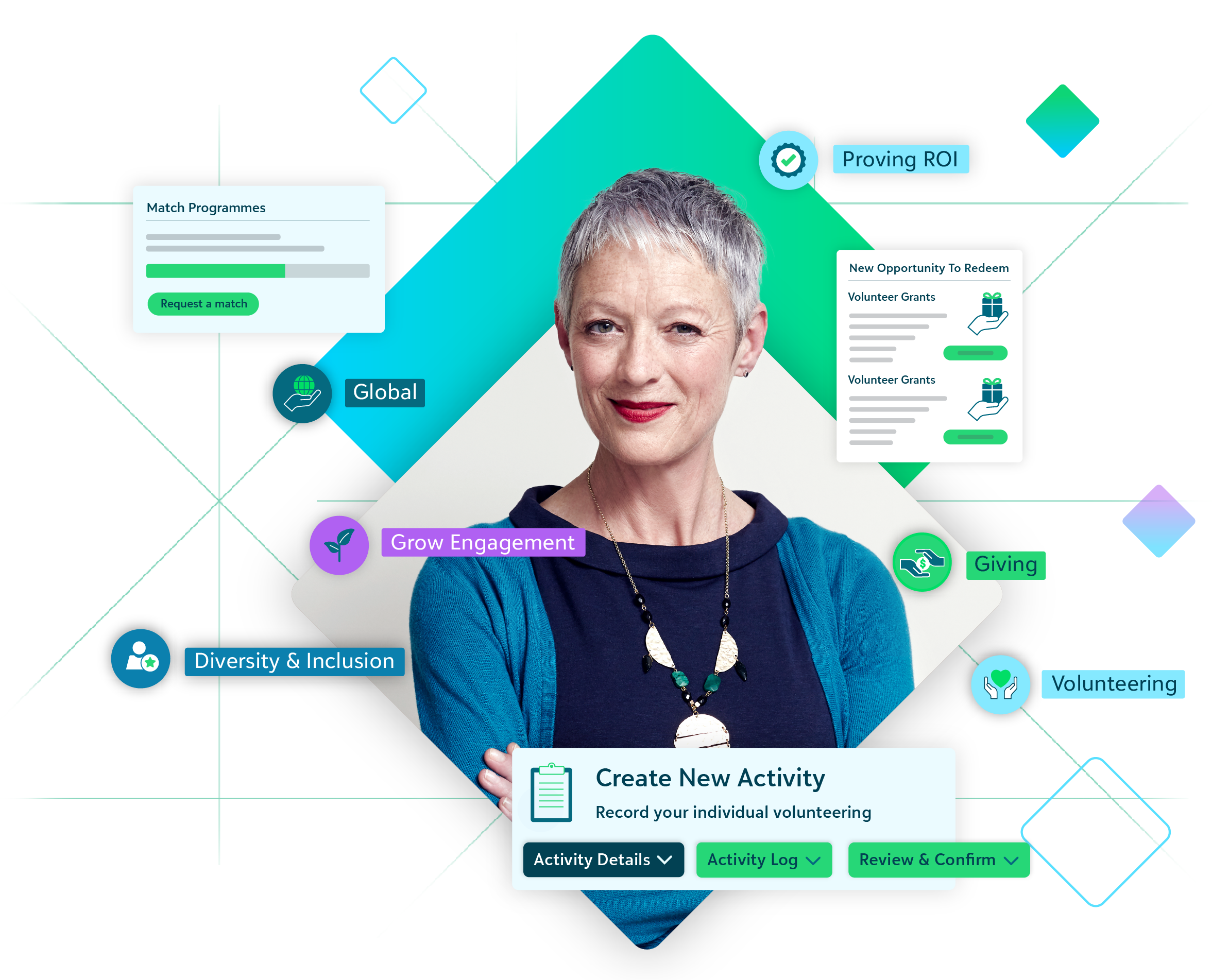CSR Strategy Development & Implementation Tips
Building a Purpose-Driven CSR Programme

Use these links to jump to a section on this page.
What is Corporate Social Responsibility?
Corporate social responsibility follows the belief that in order to have long-term success companies need to build and maintain successful relationships with a wide range of stakeholders including their partners, consumers, employees, the community they operate in, and their governments.
There are several reasons why companies large and small develop socially responsible initiatives:
- The world is facing unprecedented challenges connected with environmental issues, social justice and economic prosperity.
- People are paying attention to a company’s support of their employees, their community and their customers.
CSR enables companies to provide support and respond to the needs of their stakeholders.
“Regardless of which strategy you choose, the most important part is preparation. Strategies cannot be created overnight. If you think CSR is something you want, the time to start making connections and planning is now.”
Getting Started with CSR
We get it. Starting a corporate social responsibility programme can feel overwhelming. You probably have hundreds of ideas swimming through your head – and in a perfect world, or on any other team, you could simply run with them. But CSR is a little different. It requires buy-in from key stakeholders, data analysis, strategic planning and finding the right partners. Then, even if you manage to pull it all together, employee engagement might take time to grow.
So, as a practitioner new to CSR, where do you begin?
Building the Business Case
Determine Your Goals and Start with the Big Picture
Many executives are aware of the benefits that CSR programmes offer a corporation. But sometimes, our leadership teams need a reminder that CSR is more than a “nice-to-have”. It’s a means through which companies increasing employee engagement, productivity, and retention – which in turn leads to better business results.
Social responsibility also creates increased consumer support and a better company reputation (both which affect the company bottom line positively.) Linking CSR business goals and your company’s bigger picture helps executives understand the need based on what is important to them: making money!
Don’t worry, this isn’t a bad thing. After all, if your company didn’t make money, there wouldn’t be a CSR programme to engage with.


+20%
CSR programmes have shown to increase revenue up to 20%. -Project ROI CSR Report
64%
chief executives think that CSR is core to the business. -PwC Research
78%
of people want to work for a purpose-led company.-Porter Novelli Study
85%
of UK consumers are more likely to support a brand with purpose.-Zeno Strength of Purpose Study
Designing and Growing Your CSR Programmes
A successful CSR programme is one that aligns with your company’s values. Therefore, before even jumping into social impact ideas or strategies, you must first consider the bigger picture. Identifying corporate vision, values, and philosophies pertaining to CSR now will allow you to align policies, strategies, and even your future software solutions later.
Corporate Social Responsibility Toolkit
This toolkit provides resources for starting a CSR programme and expanding a programme globally.

Driving Employee Engagement
3 Important Things to Remember
Anyone involved in Employee Engagement knows that it impacts profitability, productivity, customer experience, and employee retention. Marketing Communications, Public Relations, CSR, Human Resources, and Business Lines, join together for Employee Engagement and develop your internal pop-up groups, task forces, response teams to determine how to best coordinate, reach, and engage your colleagues.
- Employees want to be engaged with work and their colleagues.
- Employees want to give to the causes they believe in and make a positive impact on their community.
- Offering virtual, digital, or responsible in-person volunteer opportunities are necessary for accommodating diverse employee needs.
Promoting Employee Wellness
Providing employees the opportunity for to support causes they care about not only benefits the communities they are serving, but it also benefits their overall wellbeing while making them feel more united and supported by their company. According to research conducted by Oxford University, unlike traditional wellness programmes, volunteering is the only intervention that genuinely boosts employee well-being, significantly enhancing employees’ mental health and job satisfaction. Happier employees, in turn, can lead to 12 percent increase in productivity.
Providing Employee Relief Grants
In times of crisis, many companies active in the CSR space know what it means to rally to provide aid, awareness, and relief. They create campaigns and devote time, energy, and funds in targeted efforts to help those in need following a disaster. This support is essential for the affected communities, but did you know Disaster Relief campaigns are also a powerful way to engage employees? This type of activity provides opportunities for employees to contribute to meaningful causes, fostering a sense of purpose and connection to the company’s values, ultimately boosting morale and loyalty. For guidance on planning a disaster response campaign, check out our Disaster Response Checklist.
Virtual Engagement
Even before the global pandemic, technology has been a leading method of engaging employees. Remote work grew to be the norm during the pandemic and many of those companies are continuing to employ a hybrid or fully remote workforce. The challenge – how do companies create meaningful volunteer opportunities for their remote and global employees? Get in touch with our team of experts to find out how you can leverage CSR software to build programmes that engage, connect and create impact.
Incorporating DEI
Diversity, Equity, and Inclusion Through a CSR Lens
Diversity and inclusion strategies have many elements, but at their core, they’re about creating a workplace where everyone feels encouraged to bring their whole selves to work, where uniqueness is recognised and valued, and where advancements are based on an individual’s accomplishments. Diversity and inclusion creates a fully engaged group of employees, and a company-wide culture that people want to be a part of.
One of the most powerful ways to engage employees is to allow them to self-identify through Employee Resource Groups (ERGs). These groups are a safe space to recount shared experiences, to learn together, and to advance professional development in a more personalised way.
Global Considerations
Culture and International Interests
Different countries have different understandings of philanthropy and who should be responsible for taking care of social issues. For instance, in some countries, the government is solely responsible for creating social impact programmes. The key to successful global CSR lies in understanding and adapting your programmes to the culture where your employees are based.
You will also have to consider the interests of your international employees. If you want to all employees in your company, regardless of location, to engage with your programme, you must ensure that your charitable focus matches the interests of your international team as well as the global vetted nonprofits and causes in their areas. Completing proper vetting and research ensures opportunities are available before asking your employees to engage.
Barriers and Launch Considerations
As with any global team, you may encounter language barriers within your corporation. With thousands of languages spoken throughout the world, this is a very common setback. To overcome this challenge, it is crucial that you:
- Understand the preferred languages in the locations your employees are based.
- Make sure your message is translated into the appropriate tongue.
It is important that your social impact messages come across in the way they were intended, no matter the language they’re heard in. Relying on ambassadors to ensure that the translation is made successfully can mitigate that risk. If you really want your global employees to know you have taken them into consideration, converting things such as time zone or currencies is a thoughtful way of relating to their world.
A common question asked by global organisations is: Should we launch our CSR programme in one location at a time or within the entire company?
Every company is different; however, many have found that a tiered launch means that you can work out the kinks on a smaller scale, finalise messaging, and ensure your programme is well received before rolling it out globally.
Aligning to the SDGs | Measuring Impact
The corporate philanthropic community has been working hard to make an impact on the UN Sustainable Development Goals. There are many resources that can be leveraged by CSR professionals interested in aligning organisation goals to supporting the SDGs. According to a PwC reporting challenge, 72% of companies evaluated mention the SDGs in their reports and 25% of companies include the SDGs in their published business strategy.


